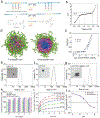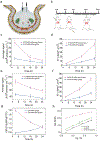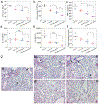Bioresponsive Nanoparticles Targeted to Infectious Microenvironments for Sepsis Management
- PMID: 30203430
- PMCID: PMC6197919
- DOI: 10.1002/adma.201803618
Bioresponsive Nanoparticles Targeted to Infectious Microenvironments for Sepsis Management
Abstract
Sepsis is a life-threatening disease resulted from a dysregulated host immune response to bacterial infections, continuing to cause high morbidity and mortality worldwide. Despite discoveries of many potential therapeutic targets, effective treatments of sepsis are lacking. Here, a strategy is reported to target infectious microenvironments (IMEs) via bioresponsive nanoparticles that simultaneously eliminate bacteria and alleviate the host inflammation response, thus managing sepsis in mice. The nanoparticle is made of copolymers sensitive to pH and bacterial enzymes to self-assemble into a micelle loaded with both an antibiotic (ciprofloxacin) and an anti-inflammatory agent ((2-[(aminocarbonyl)amino]-5-(4-fluorophenyl)-3-thiophenecarboxamide). In addition, the nanoparticle is conjugated with intercellular adhesion molecule-1 antibodies to target IMEs. Nanoparticle targeting to IMEs and local cues as triggers to deliver therapeutics in on-demand manners is demonstrated using an acute lung bacterial infection mouse model. In the sepsis mouse model induced by peritonitis at a lethal dose of bacterial invasion, it is shown that concurrently targeting pathogens and excessive inflammation pathways is valuable to manage the sepsis. The study illustrates not only the development of a new delivery system but also the mechanism-based therapy of nanomedicine for infectious diseases.
Keywords: infectious microenvironments; nanoparticle; sepsis; targeted drug delivery.
© 2018 WILEY-VCH Verlag GmbH & Co. KGaA, Weinheim.
Conflict of interest statement
Conflict of Interest
The authors declare no conflict of interest.
Figures






References
MeSH terms
Substances
Grants and funding
LinkOut - more resources
Full Text Sources
Other Literature Sources
Medical

